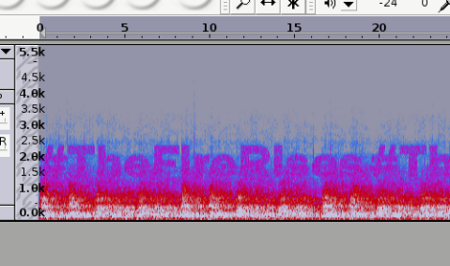
[Alex] tiped us off about the evil sounding noises coming from http://www.thedarkknightrises.com/. when you go there your pretty much greeted with a wav file and if you have a quick eye on the status bar its pretty easy to get the direct link to the file and download it. Thats all great, but why would you want to?
Well if you play back the file in a program that supports spectrograms (like audacity) you will find that there is a twitter hash hidden within the audio spectrum, that presents itself as plain text in a pretty well rendered font. Of course this leads you to another part of the site where yet another puzzle awaits you.
While this is all an interesting way to stir up buzz about the upcoming (Batman) movie, we found hiding plain text in an audio file pretty wild, though its been done before or better such as the post we had not too long ago about Ham’s packing QR codes in a similar way.
















We were doing this years ago see unfiction.com you cann doctor any wav file with minimal interference (sounds like static on playback) by just editing the wav in raw/hex and just type in what you want
http://www.bastwood.com/?page_id=10
not pr0n
@neorazz The message #TheFireRises is in the magnitude plot of frequency domain data (FFT/DFT), not directly in the actual wav file data.
I have never seen anyone hide information in the phase of the frequency domain. People only try and hide data in the magnitude.
The first time I saw anyone hide data in the magnitude part of the frequency domain was in 1991, but I’m positive he wasn’t the first.
@neorazz, this isn’t what you’re describing – just putting characters into the wav wouldn’t make it show up on as rendered text on a spectrogram like that..
Old hat. Chemical brothers did this YEARS ago.
I reckon one of the best-known examples of this can be found in Aphex Twin’s “Windowlicker”: http://www.bastwood.com/?page_id=10
My bad.. Aphex Twin….
http://www.partyutah.com/edm/showthread.php?t=6794&page=1
Same difference.. wild out there music. they were doing this in 2007….
Richard D. James would like to have a word with you.
http://www.youtube.com/watch?v=M9xMuPWAZW8&feature=player_detailpage#t=320s
@5:28
There’s a free program called Coagula lite that does this kind of additive synthesis. You feed it an image and it produces a .wav file with the correct spectral content.
Looking at a normal spectrum would produce a single line, or collection of dots, one dot representing the magnitude of a frequency.
I’m assuming the above image is the result of a waterfall-like plot, overlaid on the same plot? So, essentially, what we’re looking at is a number of plots, aggregated?
Is this the default behavior of audacity’s spectrum analyzer?
Is this the default behavior of audacity’s spectrum analyzer?
yep
At the SF Bay Area Maker Faire last weekend we showed many examples of radio modulation, with big waterfall displays from SDR and digimode programs.
fldigi includes a way to specify text that shows up in the waterfall, mostly for things like “CQ” which I showed in 2004 (http://wa5znu.org/log/2004/09/psk-visual-cq.html ), and I got the idea from the Aphex Twin example and baudline. Now it’s pretty common in digimode programs.
We also showed an analog slow-scan picture mode in MFSK, which sends small photos in a minute or two, in color or black and white.
But my favorite thing we showed was Hellschreiber, which is really ancient (predates radio) way of sending text by having a fast and a slow scan and then turning the transmitter on for a dot and off for a space. Yes, it’s a font. The Germans used in in WW2, but it’s older than that, so it was done with electromechanical devices originally.
Murry ZL1BPU has a great page about all the various “fuzzy” modes in use today: http://www.qsl.net/zl1bpu/HELL/Index.htm
there’s got to be more to the puzzle than just the audio leading to a twitter leading to a picture. The picture is made of a mosaic of other twitter followers, but if you view the image you get
http://c3315141.r41.cf0.rackcdn.com/forhashtagUnaltered9374.jpg
That has to be another clue!
hadVERTISING?
Also, “your” vs “you’re”. If you’re going to advertise to me, at least try a bit harder.
quick eye? what about viewing the source …
source has
“show_am_i_in_here_twitter”:”0″,”show_am_i_in_here_facebook”
so there is a facebook profile as well
http://uvb-76.blogspot.com/2010/09/probably-first-ever-in-history-graffiti.html
Has anyone thought about the fact that there could be information hidden in the rest of the audio signal? You know, the part below 3khz?
[youtube http://www.youtube.com/watch?v=DagI_oevvPc&w=425&h=349%5D
@Ben Ryves @fartface
Damn right. Aphex Twin – “Formula” is gold
http://www.youtube.com/watch?v=S64FROErFYA
hackthissite.org has a few labs with this. pretty neat.
There is a way to embed subliminal messages into any song or video file
http://www.subliminizer.com has a free subliminal player